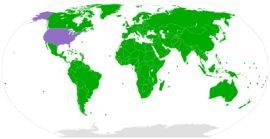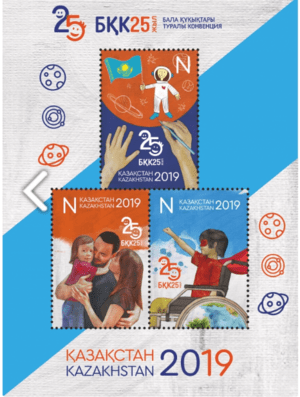Convention on the Rights of the Child facts for kids

Parties to the convention
Signed, but not ratified Non-signatory |
|
| Signed | 20 November 1989 |
|---|---|
| Location | New York City |
| Effective | 2 September 1990 |
| Condition | 20 ratifications |
| Signatories | 140 |
| Parties | 196 (all eligible states except the United States) |
| Depositary | UN Secretary-General |
| Languages | Arabic, Chinese, English, French, Russian, Spanish |
The United Nations Convention on the Rights of the Child (often called the CRC or UNCRC) is an important international agreement. It lists the basic rights that all children should have. These rights cover many areas of a child's life. They include civil, political, economic, social, health, and cultural rights.
The convention says that a child is anyone under 18 years old. This is unless the laws in their own country say they become an adult earlier. Countries that have ratified (agreed to follow) this convention must obey its rules. If a country has signed but not ratified it, they still shouldn't do anything against its main goals.
The UN has a special group called the Committee on the Rights of the Child. This group has 18 experts. Their job is to check if countries are following the convention. Governments must report to this committee regularly. They talk about how they are improving children's rights in their country. The committee's reports are available online for everyone to see.
People can contact the Committee on the Rights of the Child if they think their rights under the convention have been broken. The committee can also start its own investigations. This happens if they have good reason to believe a country has violated the convention.
The UN General Assembly officially adopted the convention. This happened on November 20, 1989. It became law on September 2, 1990. This was after enough countries had agreed to follow it. As of today, 196 countries are part of this agreement. This includes almost every country in the United Nations. The only exception is the United States.
What the Convention on the Rights of the Child Covers

This convention focuses on the special needs and rights of children. It states that countries agreeing to it must follow international law. These countries must always act in the best interests of the child.
The convention says that every child has basic rights. These include the right to life. They also have the right to their own name and identity. Children should be raised by their parents within a family or cultural group. They also have the right to a relationship with both parents, even if the parents are separated.
The convention makes sure parents can carry out their responsibilities. It also says children have the right to share their thoughts. Their opinions should be heard and considered when it's right. Children must be safe from abuse or exploitation. Their privacy should also be protected. The convention wants to make sure children's lives are not interfered with too much.
The convention also says that children should have their own legal help in court. This is for any legal issues about their care. It also asks that the child's views are heard in these cases.
The convention protects children from very harsh punishments. It states that countries should work to stop all cruel or harmful punishments for children. Article 19 of the convention says countries must protect children from all forms of physical or mental violence.
The European Court of Human Rights has used this convention. It helps them understand and apply the European Convention on Human Rights.
Countries That Are Part of the Convention
The term "party" means a country has officially agreed to follow the treaty.
As of July 12, 2022, 196 countries are parties to the UNCRC treaty. Some countries have made small changes or interpretations. Almost every country in the United Nations has agreed to these rights for children under 18. The most recent countries to join were the Cook Islands, Niue, the State of Palestine, and the Holy See.
See also
In Spanish: Convención sobre los Derechos del Niño para niños

